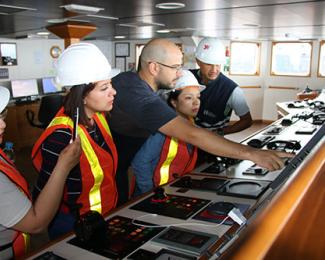Technology Supports 4,000 Children in and at Risk for Child Labor
"We can immediately assess the needs of the children and whether they are still studying or not. So that’s the beauty of it."
Armed with smartphones, every six months 170 volunteers visit homes and farms across three provinces in the Philippines. As members of local Child Protection Groups, they meet with families and children who are in or at risk of child labor and collect important data that can help kids get out of child labor.
Remarkably, for more than two years, these 170 individuals have gathered and managed data on nearly 4,000 children* with the support of an open-source data collection tool called KoboToolbox. This information feeds into a new child labor reporting mechanism and referral system created by the Building Capacity, Awareness, Advocacy and Programs project (BuildCA2P).
Funded by the U.S. Department of Labor’s Bureau of International Labor Affairs and implemented by ChildFund International, the project is building the capacity of civil society in Mindanao, Philippines to better understand and address child labor and promote acceptable conditions of work in the production of bananas, coconuts, corn, and rice.
Mindanao has one of the highest populations of child laborers in the country, and more than half of them are working in dangerous conditions in agriculture. Many kids work up to ten hours per day without adequate protection or rest time. While the government prohibits the employment of children below age 15, plantations often use a quota system that can lead to children working. When adults fail to meet their quotas, their children, some as young as five, contribute with their labor. Civil society and the government are working to end this.

Training on KoboToolbox. Photo by ChildFund.
Robello Tizon is one of the volunteers who plays a critical role in the new child labor reporting mechanism and referral system. She is a member of her local Community-based Child Protection Group. Twice a year, she travels house to house to speak with children and their families. Using the app, she inputs data on whether children are in or out of school and learning at grade level; are engaged in child labor, are at-risk, or have left child labor; what crops they are farming; what hazards they face on the job; how many hours they work; and who they are living with; among other data points. Her travel, meals and phone data costs are covered by BuildCA2P.
It's a lot of data, but Robello and her fellow volunteers can input it in half the time that it took before KoboToolbox.
“We can immediately assess the needs of the children and whether they are still studying or not. So that’s the beauty of it.”
Before the new reporting and referral system, there was no system in place to securely track and monitor cases of child labor in Mindanao’s provinces of North Cotabato, Bukidnon, and Davao del Norte due to limited resources.
With the new easy-to-use reporting and referral system integrated into Local Government Units, families can now access timely help, so they can put food on the table without relying on the labor of children. Cases of child labor can be reported and addressed quickly and comprehensively by civil society and government.
Once the data is collected, the project sends it to key local government agencies, including the Local Council for the Protection of Children, Municipal Social Welfare and Development Office, health authorities, and the police. They offer qualified families services, including legal aid, psychosocial care, livelihoods kits for caregivers, access to alternative education, and more. When these agencies can’t provide services directly, they refer children and families to civil society organizations and churches that can assist.
In the municipality of Alamada, North Cotabato, Aloha Tenorio Ballos takes pride in her role in the system. As the Municipal Social Welfare and Development Officer, she helps provide social protection to vulnerable families and ensures local NGOs have the case information they need to provide additional assistance.
This network is essential to addressing child labor in her municipality, she says.
“To reach a goal, you need to plot your steps forward. You need allies that share the same vision and linkages to form a united front against a tough issue.”
This new system makes that collaboration seamless, so government and civil society allies can get closer to their goal of ending child labor.
She says her dream “is for the children, not only here in Alamada, but also in Mindanao and the Philippines... to fully exercise their rights and be protected from abuse.”
*As of March. 2023 the child labor reporting mechanism and referral system was serving 3,983 children across the provinces of North Cotabato, Bukidnon, and Davao del Norte on Mindanao.




















